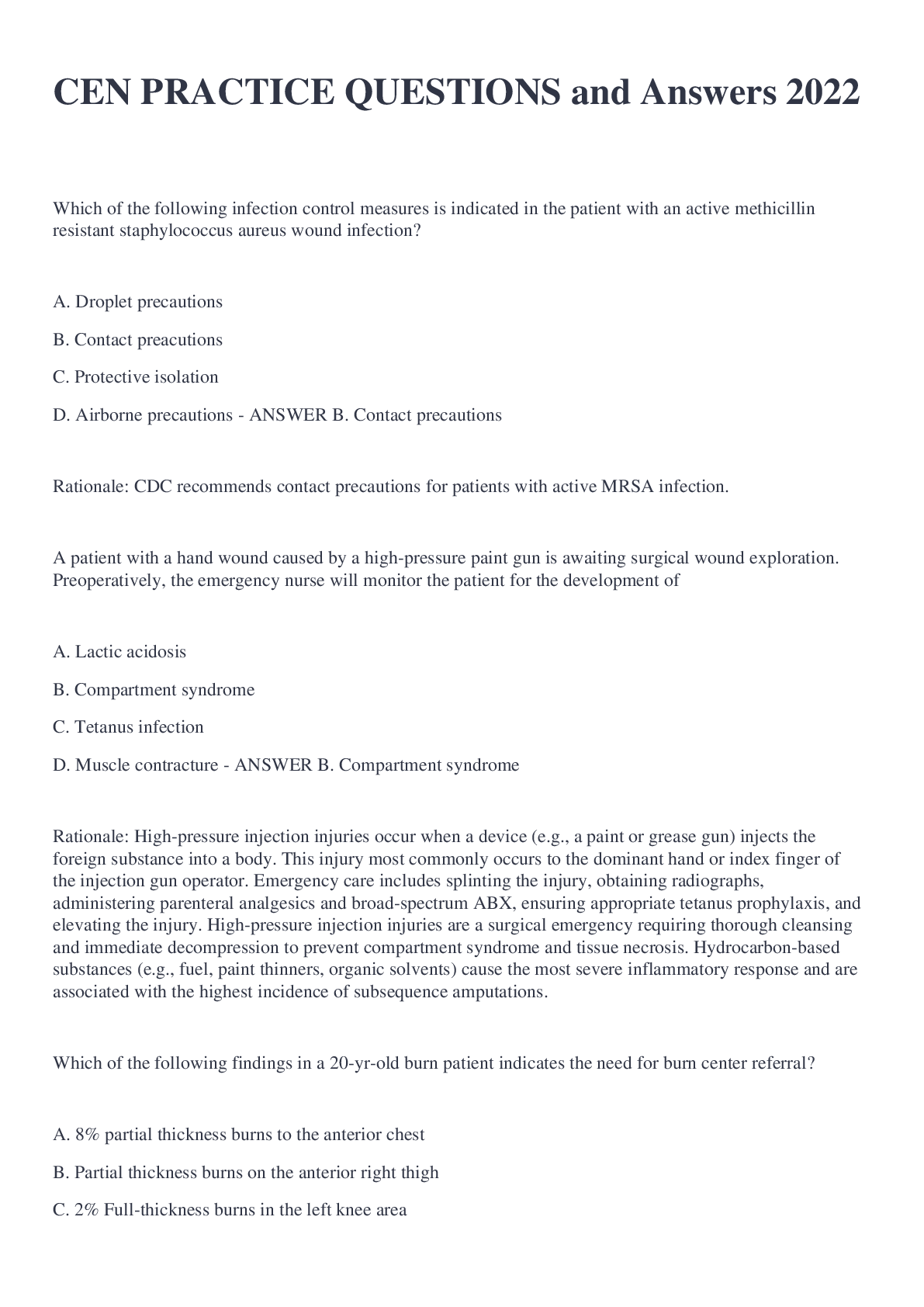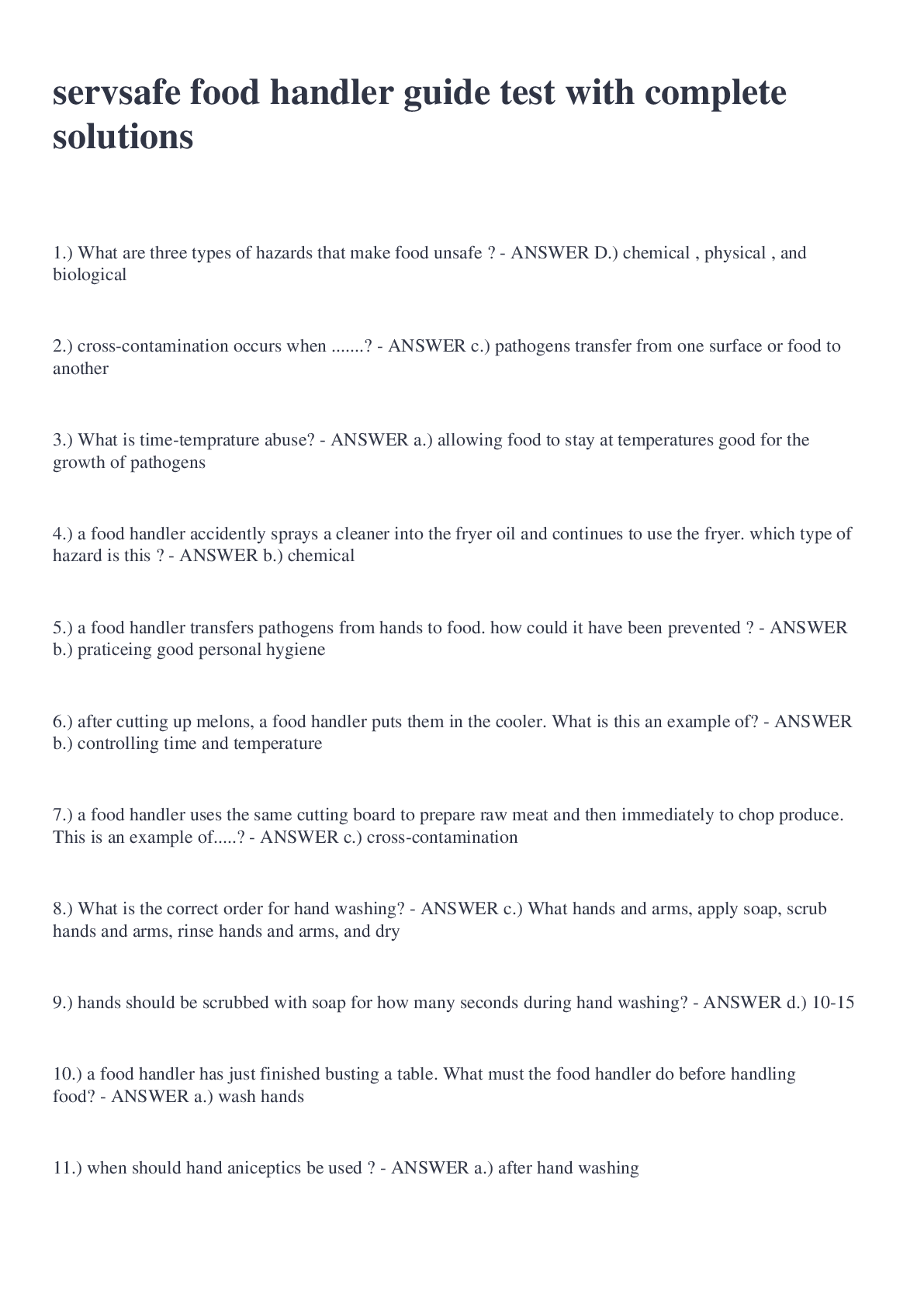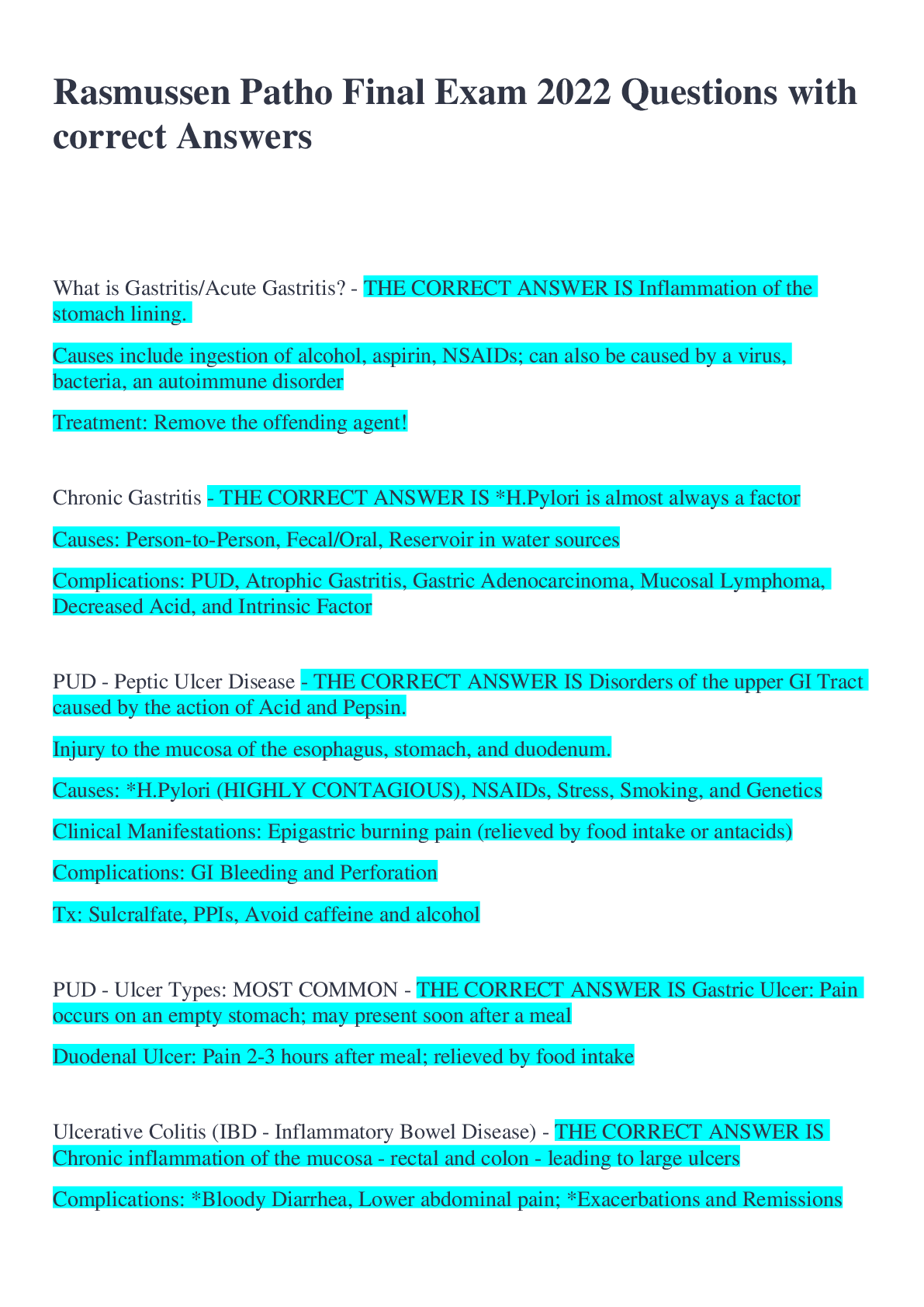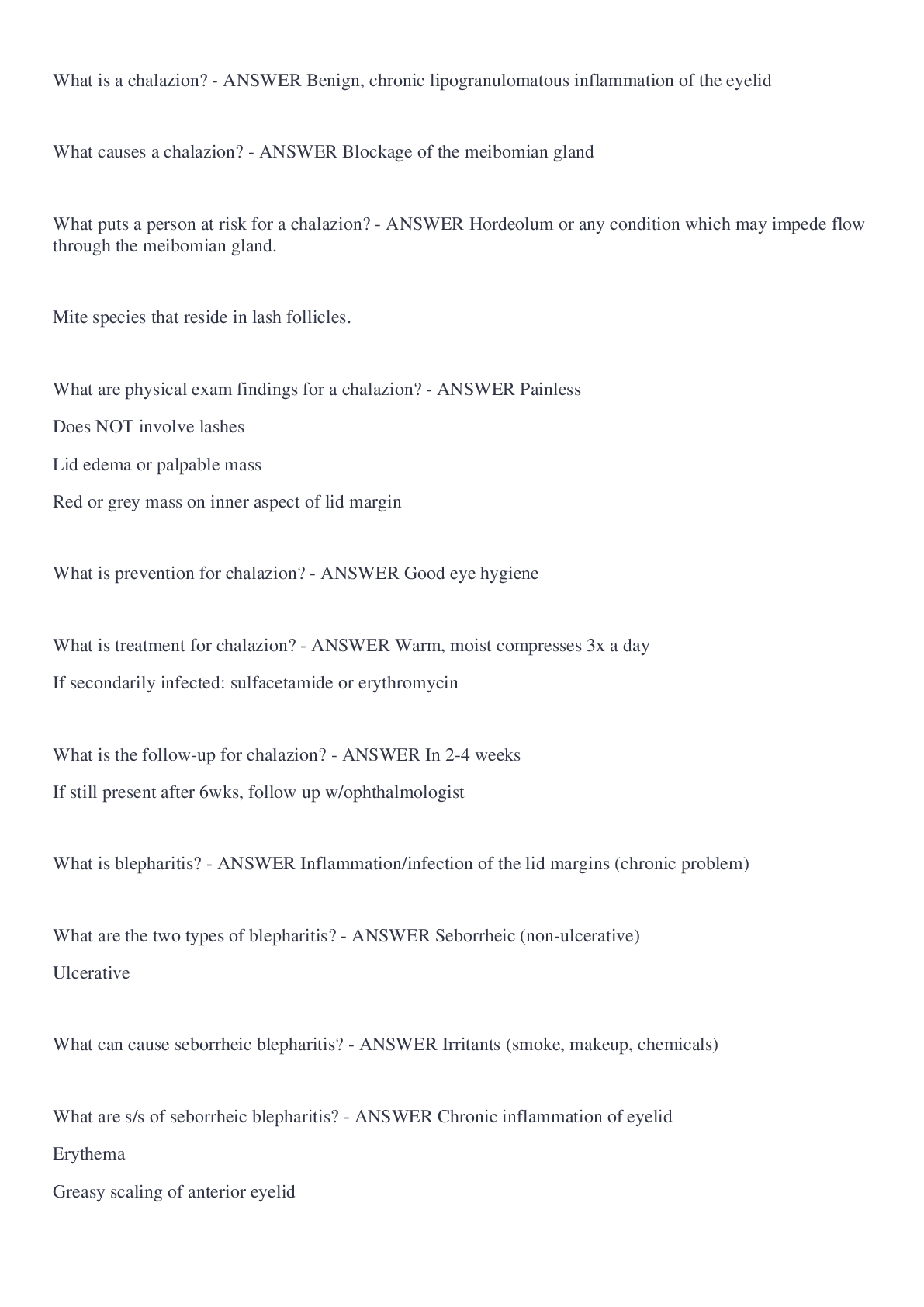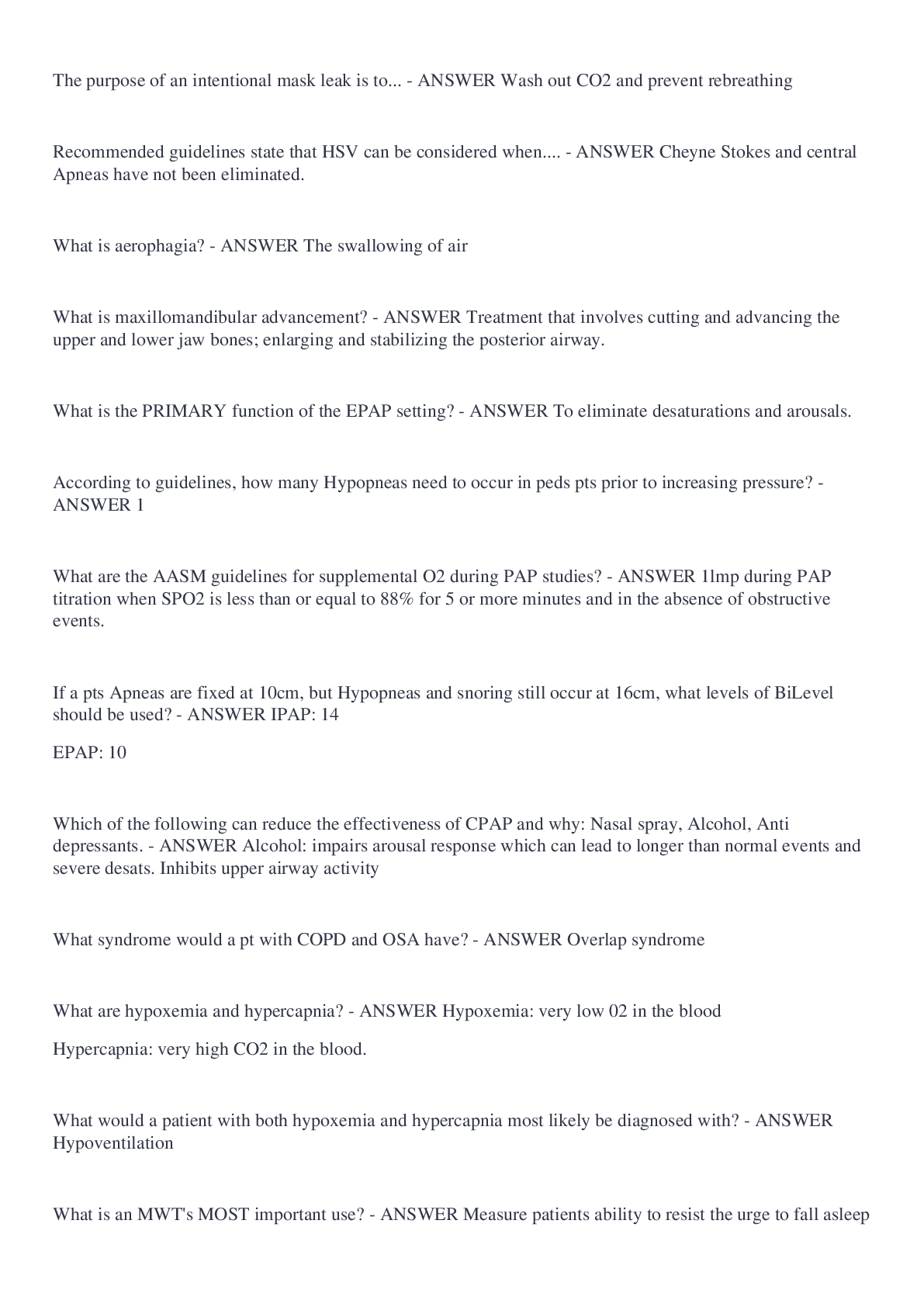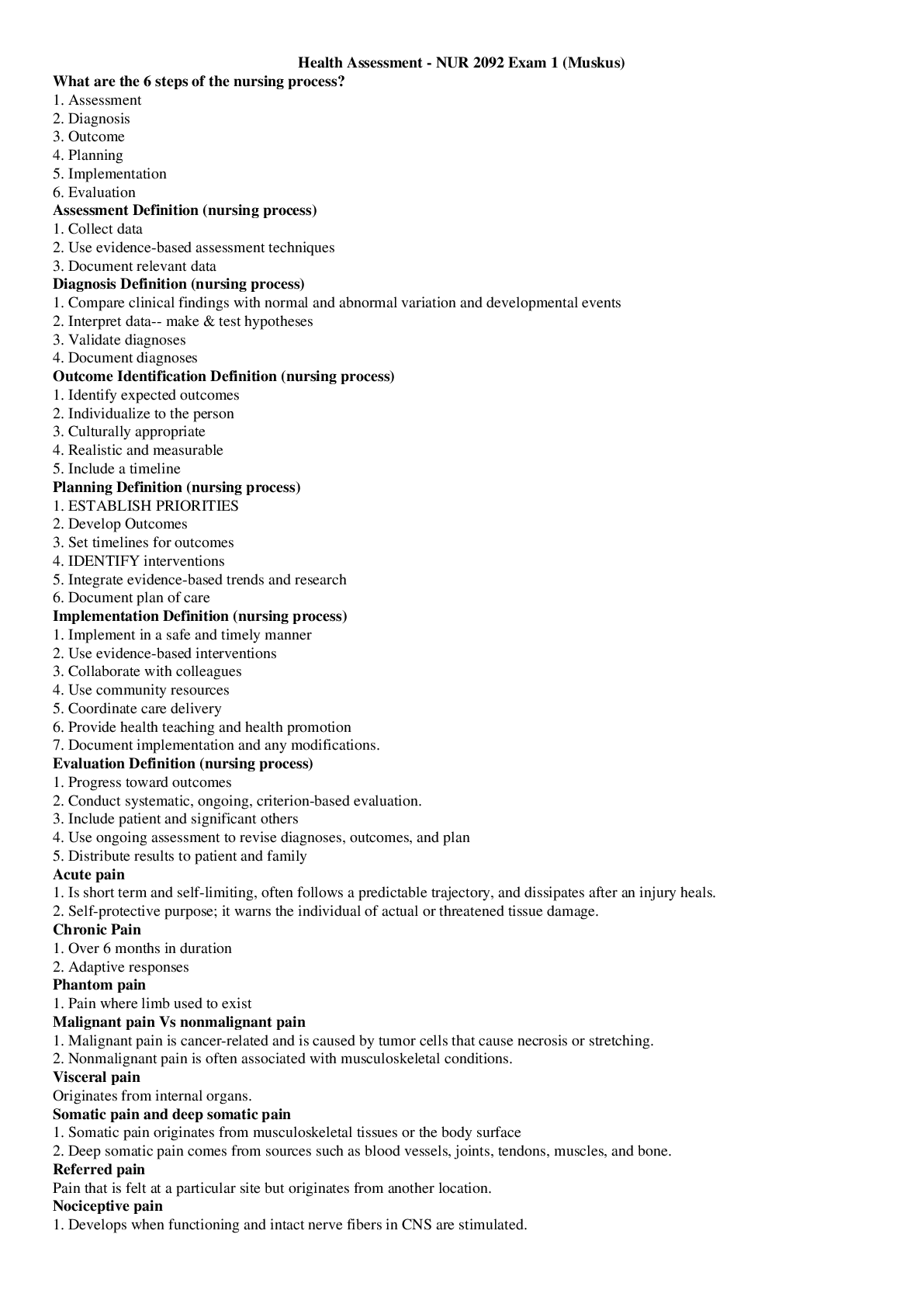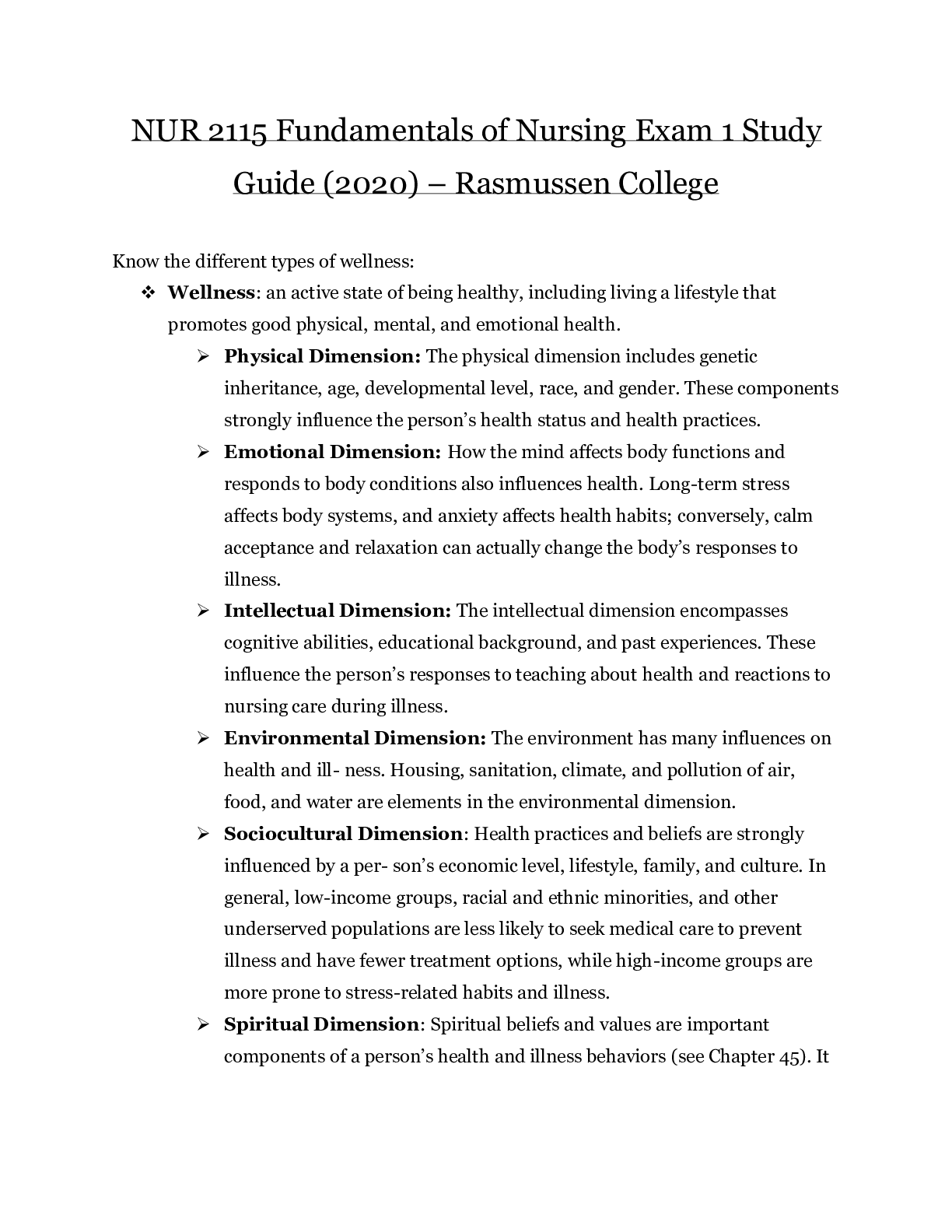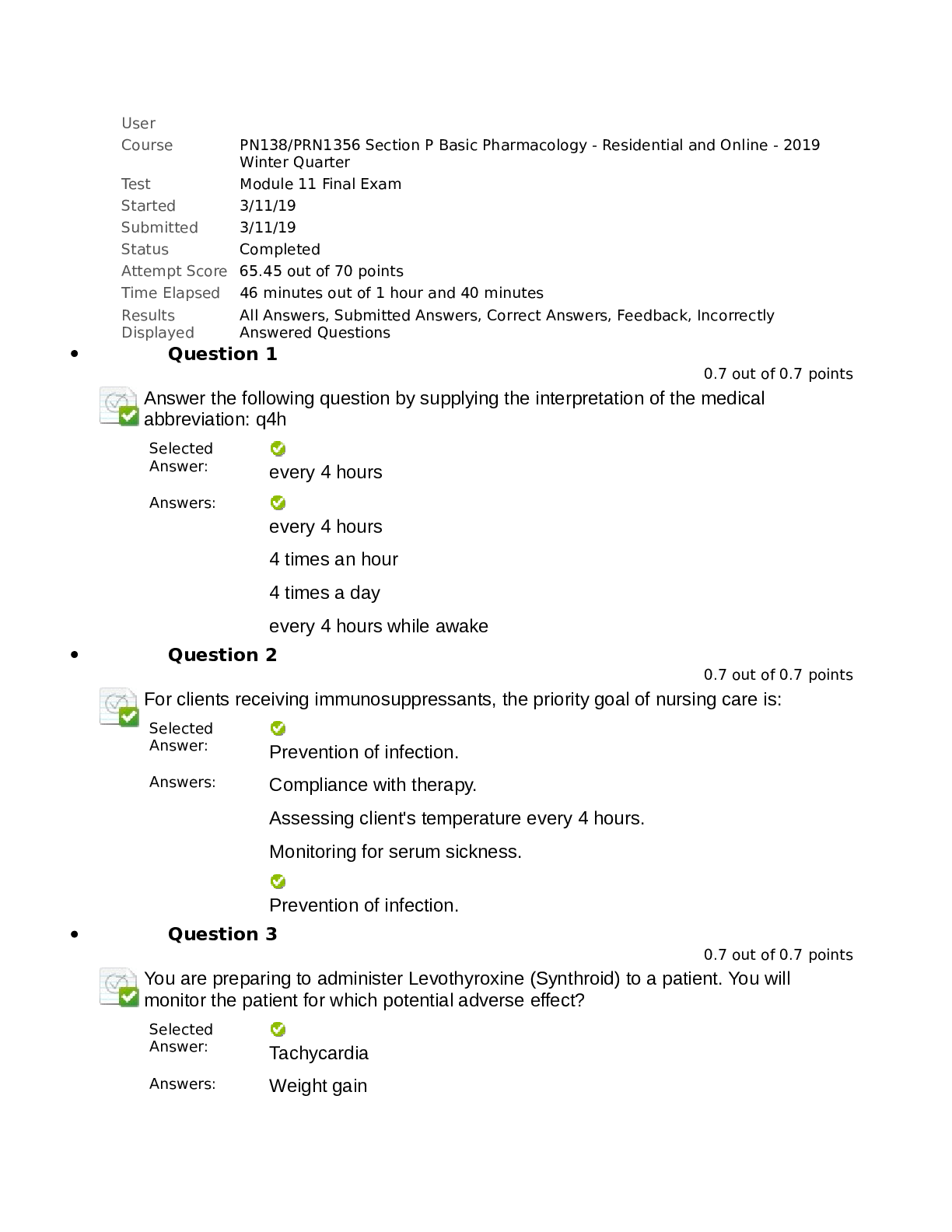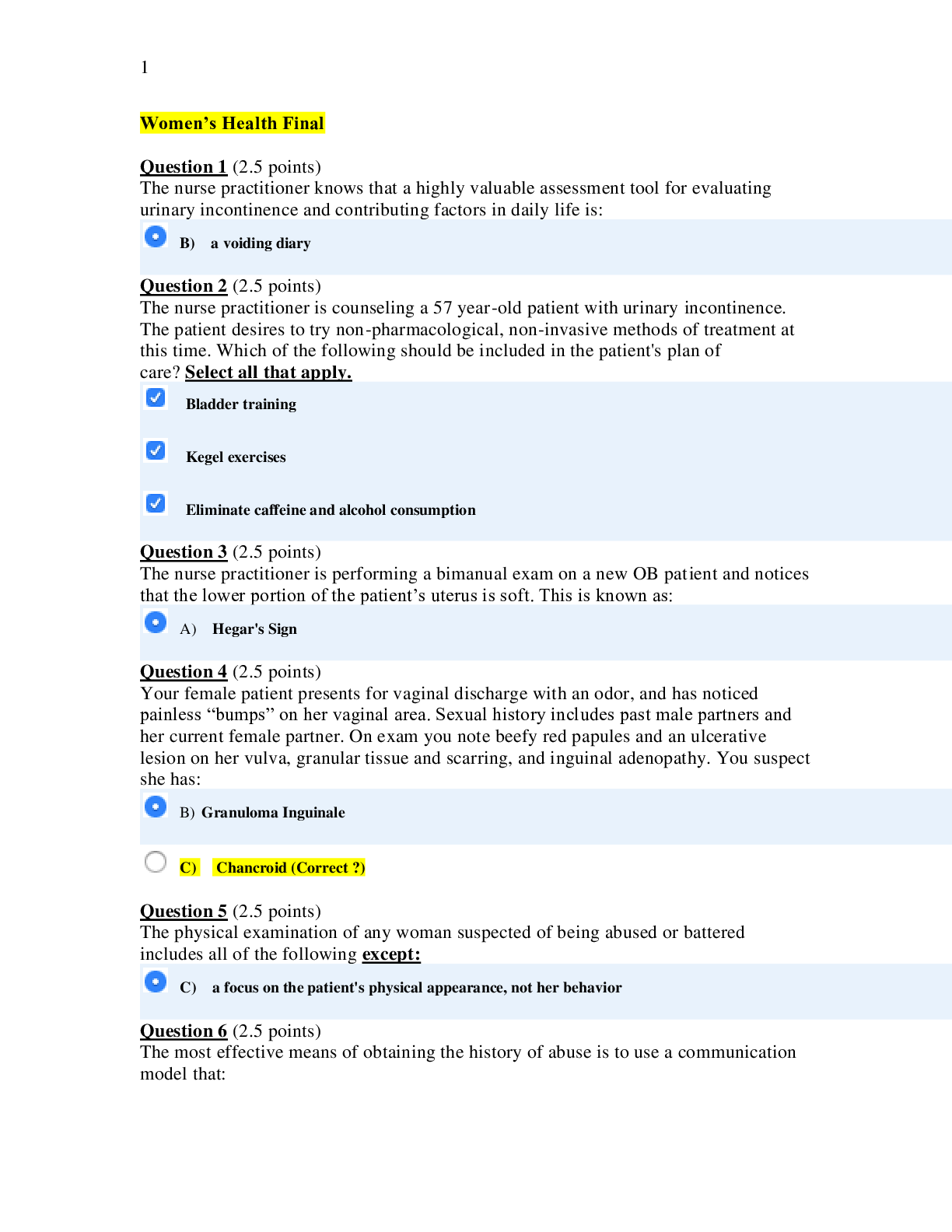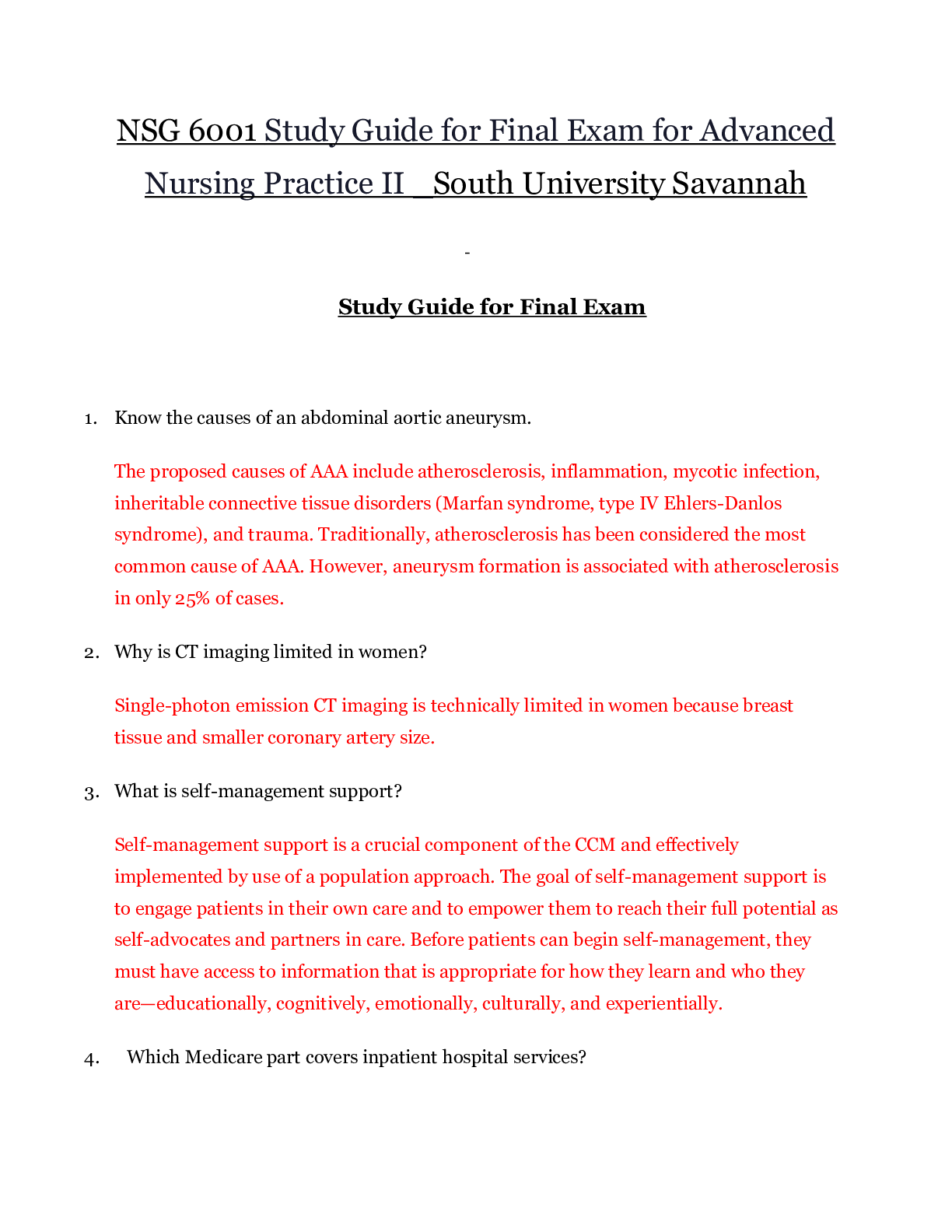Pathophysiology > EXAM > Pathophysiology a Practical Approach Exam 1 Study Guide with complete solution (All)
Pathophysiology a Practical Approach Exam 1 Study Guide with complete solution
Document Content and Description Below
hypersensitivity - ANSWER -Inflated immune response to a foreign substance type I hypersensitivity - ANSWER -Immediate response -Local or systemic -Allergen activates IgE which binds to mast cell... s -Second exposure causes antigen to bind to surface IgE, releasing mediators and triggering the complement system -Hay fever, food allergies, anaphylaxis type II hypersensitivity - ANSWER -Cytotoxic hypersensitivity reaction -IgG or IgM antibodies -Complement system destorys blood cells -Usually an immediate response -Blood transfusion reaction and erthroblastosis fetalis type III hypersensitivity - ANSWER -Immune complex-mediated hypersensitivity -Circulating antigen-antibody complexes accumulate and are deposited in tissue -Triggers the complement system and inflammation -Autoimmune conditions such as lupus -Tx is disease specific type IV hypersensitivity - ANSWER -Delayed hypersensitivy reaction -T-cell mediated -Tuberculin skin testing, transplant reactions, contact dermatitis -Tx is disease specific allogenic transplant - ANSWER -Donor and recipient share similar tissue types -Unrelated or related syngenic transplant - ANSWER -Donor and recipient are identical twins autologous transplant - ANSWER -Donor and recipient are the same person hyperacute tissue rejections - ANSWER -Occur immediately or up to 3 days after transplant -Triggered by the complement system -Tissue becomes permanently necrotic acute tissue rejection - ANSWER -Most common tissue rejection -Treatable -Between 3 days and 4 months after transplant -CM: fever, erythema, edema, site tenderness, impaired function of transplant organ chronic tissue rejection - ANSWER -4 months to years after the transplant -Anti-body mediated -Antibodies and complements deposit in vessel walls of transplanted tissue causing ischemia host-versus-graft rejection - ANSWER -Host fights off the grafted tissue -Recipient's immune system attempts to eliminate the donor cells graft-versus-host rejection - ANSWER -Graft fights the host -Frequent, potentially fatal -Immunocompetent graft cells recognize host tissue as foreign -Host is usually immunocompromised and unable to fight off graft cells -Occurs ONLY in bone marrow transplants systemic lupus erythematosus - ANSWER -Chronic inflammatory condition -Remission and exacerbations -Stressors tend to trigger -Progresses from mild to severe -More common in women -B cells create immune complexes that attack the body's own tissues Criteria for Diagnosing Systemic Lupus - ANSWER 1) Butterfly rash over cheeks 2) Skin rash of patchy redness with hyperpigmentation and hypopigmentation that can cause scarring 3) Photosensitivity 4) Mucous membrane ulcers 5) Arthritis 6) Pleuritis or pericarditis 7) Renal abnormalities 8) Brain irritation 9) Blood abnormalities 10) Immunologic disorder 11) Antinuclear antibody HIV - ANSWER -Parasitic retrovirus that infects CD4 & macrophages upon entry -Uses reverse transcriptase to convert RNA to DNA and then integrates its own DNA into that of the cell HIV-1 - ANSWER -Most common strain of HIV in the US HIV-2 - ANSWER -Most common HIV strain in West Africa -Progresses to disease more slowly AIDS (Dx) - ANSWER -HIV antibody: -Rapid test -Home test -PCR Category 1 AIDS - ANSWER -CD4 > 500 cells/microL Category 2 AIDS - ANSWER -CD4 = 200-499 cells/microL Category 3 AIDS - ANSWER -CD4 < 200 cells/microL Category A AIDS - ANSWER -Asymptomatic HIV infection Category B AIDS - ANSWER -Less serious clinical manifestations of immune deficiency Category C AIDS - ANSWER -AIDS defining illnesses present stress - ANSWER -universal experience -both positive and negative -response to change inflammatory manifestations - ANSWER -edema -warmth -validations -pain -erythema neutrophils - ANSWER -infection-fighting agents -usually first to arrive at the scene of infection -attracted by various chemicals -escape from capillary wall and migrate to infection site basophils - ANSWER -white blood cells that bind to IgE and release histamine in anaphylaxis eosinophils - ANSWER white blood cells involved in allergic reactions monocytes - ANSWER -WBC that replenish macrophages and dendritic cells in normal states and respond to inflammation by migrating to infected tissues mast cells - ANSWER -connective tissue cells that contain histamine, heparin, hyaluronic acid, slow reacting substance of anaphylaxis, and serotonin 3 stages of stress - ANSWER -alarm:stimulus -resistance: limiting stressor -exhaustion : not able to limit stressor 1st line of defense - ANSWER -nonspecific -distinguish self from no self -does not distinguish between pathogens -includes: skin and mucus membranes 2nd line of defense - ANSWER -responds to antigens that penetrate the first line -inflammatory response -pyrogens -interferon -complement proteins 3rd line of defense - ANSWER -specific -develops over time -uses memory system -distinguishes self from non-self and between pathogens -t cells (cell mediated immunity) -b cells (humoral immunity) active immunity - ANSWER -sources include having the disease and vaccinations -long lasting but takes a few days to become effective passive immunity - ANSWER -sources include maternal-fetal transfer of immunoglobulins and breast feeding -short lasting hyperplasia - ANSWER -An increase in the number of cells in an organ or tissue metaplasia - ANSWER -Process by which one adult cell is replaced by another cell dysplasia - ANSWER -Cell adaptation in which cells mutate into cells of a different size, shape, and appearance ischemia - ANSWER -Decreased blood flow to a tissue or organ apoptosis - ANSWER -Programmed cell death -Cells condense or shrink necrosis - ANSWER -Cell death following injury -Cells swell and burst liquefaction necrosis - ANSWER -Caustic enzymes dissolve and liquefy necrotic cells -Most common in the brain -Walled-Off -Liquid goo caseous necrosis - ANSWER -Necrosis in which the cellular debris remain in the area for months or years -Pulmonary tuberculosis [Show More]
Last updated: 1 year ago
Preview 1 out of 19 pages

Buy this document to get the full access instantly
Instant Download Access after purchase
Add to cartInstant download
We Accept:

Reviews( 0 )
$10.00
Document information
Connected school, study & course
About the document
Uploaded On
Sep 24, 2022
Number of pages
19
Written in
Additional information
This document has been written for:
Uploaded
Sep 24, 2022
Downloads
0
Views
26

